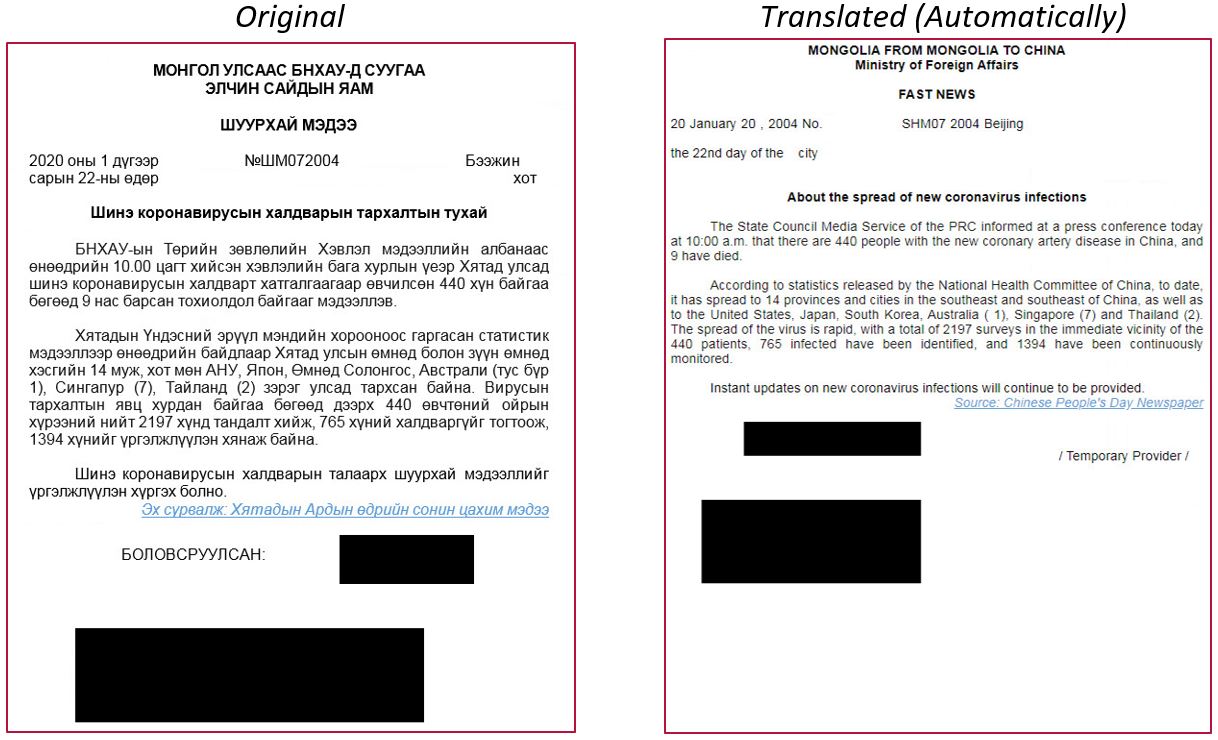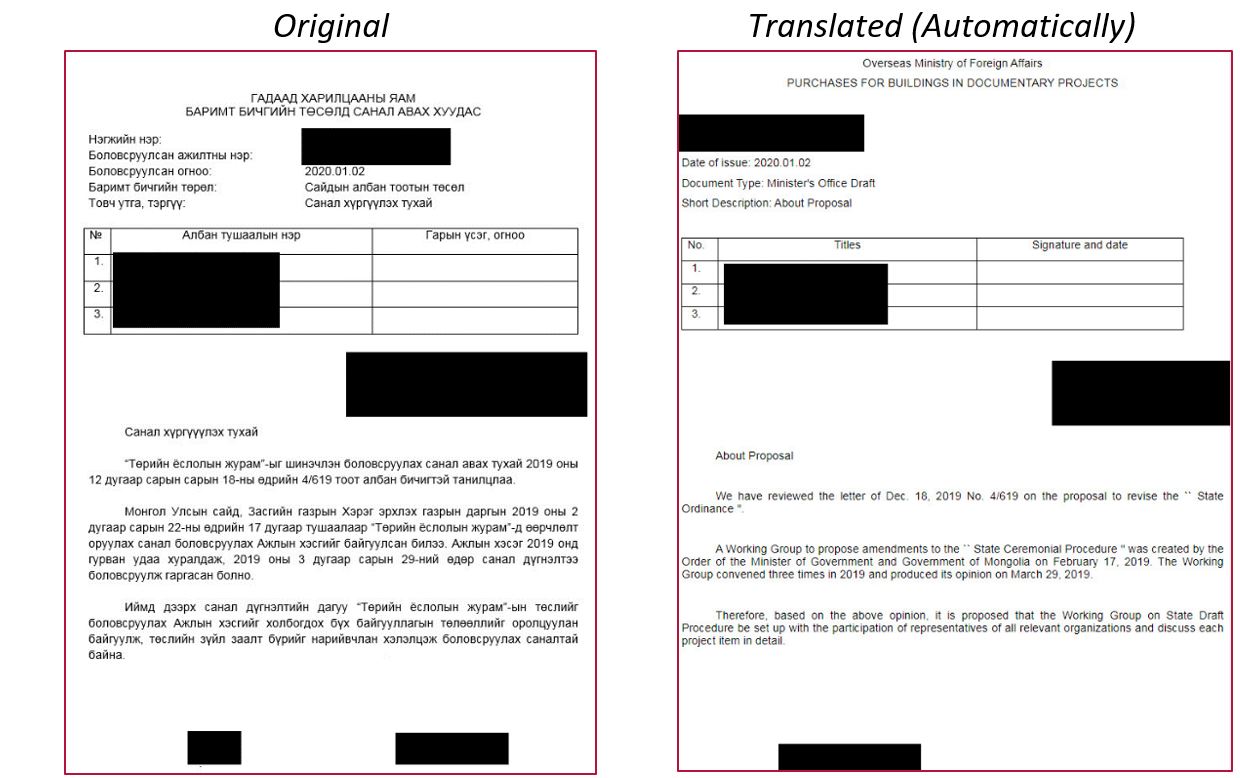

Introduction
Check Point Research discovered a new campaign against the Mongolian public sector, which takes advantage of the current Coronavirus scare, in order to deliver a previously unknown malware implant to the target.
A closer look at this campaign allowed us to tie it to other operations which were carried out by the same anonymous group, dating back to at least 2016. Over the years, these operations targeted different sectors in multiple countries, such as Ukraine, Russia, and Belarus.
In this report, we will provide a full analysis of the TTPs utilized throughout this campaign, the infrastructure, and the new tools we uncovered during our research, of what we believe to be a Chinese-based threat actor.
Lure Documents
The investigation started when we identified two suspicious RTF documents sent to the Mongolian public sector. The documents were written in the Mongolian language, with one of them allegedly from the Mongolian Ministry of Foreign Affairs:

Document 1: Information about the prevalence of new Coronavirus infections

Document 2: Purchases for buildings in documentary projects
These RTF files were weaponized using version 7.x of a tool named RoyalRoad (aka 8.t).
This tool, which is commonly used by various Chinese threat actors, allows the attacker to create customized documents with embedded objects that exploit the Equation Editor vulnerabilities of Microsoft Word.
Infection Chain
After the victim opens the specially crafted RTF document, and the Microsoft Word vulnerability is exploited, a file named intel.wll is dropped into the Word startup folder: %APPDATA%\Microsoft\Word\STARTUP.
This persistence technique is often used by newer versions of the so-called RoyalRoad. Every time that Microsoft Word application is launched, all the DLL files with a WLL extension in the Word Startup folder would launch as well, triggering the infection chain we describe below:

Infection Chain Diagram
This not only serves as a persistence technique, but also prevents the infection chain from fully “detonating” if run inside a sandbox, as a relaunch of Microsoft Word is required for the full execution of the malware.
After it’s loaded, the malicious intel.wll DLL proceeds to download and decrypt the next stage of the infection chain, from one of the threat actor’s servers: 95.179.242[.]6.
The next stage downloaded is also a DLL file, and it serves as the main loader of the malware framework developed by the attackers. It is executed using Rundll32, and it communicates with another one of the threat actor’s C&C servers (95.179.242[.]27) to receive additional functionality.
The threat actor operates the C&C server in a limited daily window, going online only for a few hours each day, making it harder to analyze and gain access to the advanced parts of the infection chain.
At the final stage of the infection chain, after the appropriate command is received, the malicious loader downloads and decrypts a RAT module, also in the form of a DLL file, and loads it into memory. This plug-in like architecture might hint at the existence of other modules, in addition to the payload we received.
The RAT module appears to be a custom and unique malware, though it also includes some rather common core capabilities, listed below:
- Take a screenshot
- List files and directories
- Create and delete directories
- Move and delete files
- Download a file
- Execute a new process
- Get a list of all services
Open Window
At the beginning of our research, one of the attacker’s servers, which served the next stage malware, had directory listing enabled for a limited time. This allowed us to download all hosted files, as well as to gain some insight into the operation timeline and the working hours of the attackers.

Open directory at 95.179.242[.]6
Even though they were available for download, all the files on the server came encrypted.
Luckily, by utilizing the same encryption scheme seen in our infection chain, we were able to decrypt most of the files stored on the server.
key = "VkvX7CK7X7*t$x&hssLR6fOyFSaKrFJKx&@#AK*Fnukj@J9J40f1mKaN$nsCNKPe"
def decrypt(enc,offset):
decrypted = ""
for i in range(len(enc)):
decrypted += chr((ord(enc[i]) ^ ord(key[(i + offset) & 0x3f])))
return decrypted
Decryption scheme derived from “intel.wll”
The dozen of files that we were able to decrypt can be divided into four main clusters of malware loader families. Their embedded internal names and core functionality are described below:
| http_dll.dll (Intel.wll) | The first stage loader described above. Decrypts the C&C address, then downloads and decrypts the next stage DLL, and executes it via Rundll32.
|
|
ppdown.dll
|
Functions as downloader and decryptor for the .rar files stored on the attackers’ server. Reads an access.txt file from the server, decrypts it and splits the result into 3 parts:1) The name of the next stage to download. 2) The next stage export function to call. 3) The decryption key for the next stage. |
| Rundll32Templete.dll | This variant serves as loader and decryptor for next stage payload. The payload is encrypted in .sect section. |
| Minisdllpub.dll | The second stage loader, fully described below. Loads additional DLL plugins. A similar version of this payload, called minisdllpublog.dll, contains some additional debug printing capabilities. |
Payload types found on the server
Connection to other samples
After gaining access to the additional decrypted files, we were able to hunt for similar samples.
Searching for similar files by the internal names (http_dll, Rundll32Templete and minisdllpub), unique exported functions (Engdic, WSSet and MSCheck) and code similarities (decryption methods, communication patterns, etc.), allowed us to find more samples related to the attacker:
5560644578a6bcf1ba79f380ca8bdb2f9a4b40b7 |
http_dll.dll |
207477076d069999533e0150be06a20ba74d5378 |
http_dll.dll |
b942e1d1a0b5f0e66da3aa9bbd0fb46b8e16d71d |
http_dll.dll |
9ef97f90dcdfe123ccb7d9b45e6fa9eceb2446f0 |
hcc_dll.dll |
cf5fb4017483cdf1d5eb659ebc9cd7d19588d935 |
Rundll32Templete.dll |
92de0a807cfb1a332aa0d886a6981e7dee16d621 |
Rundll32Templete.dll |
cde40c325fcf179242831a145fd918ca7288d9dc |
minisdllpublog.dll |
2426f9db2d962a444391aa3ddf75882faad0b67c |
IrmonSvc.dll |
9eda00aae384b2f9509fa48945ae820903912a90 |
IrmonSvc.dll |
2e50c075343ab20228a8c0c094722bbff71c4a2a |
IrmonSvc.dll |
2f80f51188dc9aea697868864d88925d64c26abc |
NWCWorkstation.dll |
Newly discovered related samples
One of the samples found (92de0a807cfb1a332aa0d886a6981e7dee16d621) led us to an article covering a similar initial infection chain, which appears to be after Ukrainian targets.
Another sample (9ef97f90dcdfe123ccb7d9b45e6fa9eceb2446f0) was originally dropped by an RTF document which appears to be targeting entities in the Russian Federation, back in late 2018.
Infrastructure
Analyzing the newly discovered samples introduced us to a larger part of the infrastructure utilized by the threat actor, and a common TTP: All the C&C servers were hosted on Vultr servers and the domains were registered via the GoDaddy registrar.

Infrastructure overview
As we analyzed this campaign, in addition to the infrastructure used, we also noticed an interesting behavior by the attackers
At a certain point, the C&C server 95.179.242[.]6 stopped serving the open directory listing. A few days later dw.adyboh[.]com became an open directory:

Open directory listing at dw.adyboh[.]com
This might indicate that the attackers are enabling directory listing, when one of their payload delivery servers is in active use.
Attribution
From the malicious document perspective, we believe that the naming scheme for intel.wll – which is dropped by version 7.x of RoyalRoad is not enough to make a clear cut attribution, as we observed the same name used by various threat actors dropping different malware families such as Bisonal and Poison Ivy.
From the payload perspective, on the other hand, once we found the additional related samples mentioned in the Hunting section above, we were able to connect it to a known threat group. In the NWCWorkstation.dll sample mentioned above, we observed a unique string as part of the logging functionality: “V09SS0lO”. This led us to an article from 2017 by Palo Alto Networks, titles Threat Actors Target Government of Belarus, which describes an attack that utilizes a RAT named BYEBY.
The article itself also connects to a previous article dating back to 2016, where the same tools were used in an attack targeting the Mongolian government. The article also explores the connections between these attacks and previous attacks related to the Enfal Trojan.
By comparing the IOCs from the 2017 attack to our campaign we observed several similarities:
Infrastructure Similarities
The servers from the 2017 publication were set on the same infrastructure as all the other samples found during our investigation, and utilize Vultr and GoDaddy services.
Code Similarities
When analyzing one of the files from the open directory (bf9ef96b9dc8bdbc6996491d8167a8e1e63283fe), we noticed that it decrypts and loads a DLL named wincore.dll. By investigating this dropped file, we were able to make several correlations to the BYEBY sample from 2017:
- String similarity:

“BYEBY” strings

“wincore.dll” strings
- Function similarity – Important functions in both
BYEBYandwincore.dllhave almost the same implementation. One such function is the payloads’ main thread function.

Malware implementation similarities
- Global Call-Graph and X-Ref Graph – Even though some obfuscation exists in both samples, we were able to verify that they have similar call and reference graphs, meaning that the core functionality of the executables is the same.
Payload – In Depth Analysis
To recap, the second stage payload in the attack chain, is an encrypted DLL file named minisdllpub.dll. The DLL, downloaded from 95.179.242[.]6, is a downloader for an additional payload. In the following section, we go over its implementation and highlight the characteristics which are unique to this payload.
Minisdllpub.dll begins by creating a mutex with the name Afx:DV3ControlHost. This is a unique indicator that can later be used to hunt for more samples in the wild. It then defines a structure of size 0x5f8 to store system and environment information such as the name of the running computer, IP addresses, the username, and OS Version. Next, another structure of size 0x3FC is created, this time to store pointers to loaded DLLs and API functions, as well as the command and control IP address (95.179.242[.]27) and port (443).
After setting up these structures, the flow continues and a new thread is created. First, it fetches several lists of API functions, and dynamically loads them. As can be seen in the following image, each list is comprised of the name of a library followed by a sequence of API functions to load from this library. Pointers to these functions are then added to the previous structure which are used to dynamically invoke them when needed.

Comma-separated lists of API functions, prepended with the library name
The second stage payload then sets up HTTP or HTTPS communication, depends on several checks, and starts communicating with its remote control in new threads. When the server replies, it sends XOR encoded DLL to the malware, with the key 0x51. Minisdllpub.dll then decodes the given payload and dynamically loads the new PE to memory.
When loaded, it searches for an export function with the name e. The malware then keeps listening to commands from the server, and when those are received, it passes them to the "e" function of the newly loaded payload. By doing so, the second-stage is operating as a middle-man between the C&C and the final payload – a remote access tool.

The malware is searching for the export function “e”, in order to invoke it
At this point, we have a unique layout of modules loaded on the victim’s computer. First, is the Minisdllpub.dll that was initially loaded using Rundll32 by http_dll.dll (intel.wll) when a Microsoft Office application was executed. Next, we have the RAT payload itself which receives its control commands not directly from the C&C, but through Minisdllpub.dll that acts as a mediator.

Loader execution flow
Interestingly, in addition to the commands to execute, Minisdllpub.dll also passes several structures to the final payload. The structures which were previously built and filled, are now used by the RAT to dynamically invoke API functions and deliver data to the C&C server. This unique approach of re-using function pointers that were loaded in the previous module makes the analyzing the RAT hardly possible without having the previous stage as well.
The supported functionalities of the final payload, as well as the respective commands it receives and sends, are described in the table in Appendix A.
Conclusion
In this campaign, we observed the latest iteration of what seems to be a long-running Chinese-based operation against a variety of governments and organizations worldwide. This specific campaign leverages the COVID-19 pandemic to lure victims to trigger the infection chain.
The attackers updated their toolset from documents with macros and older RTF exploits to the latest variation of the “RoyalRoad” RTF exploit-builder observed in the wild.
The full intention of this Chinese APT group is still a mystery, but it is clear they are here to stay and will update their tools and do whatever it takes to attract new victims to their network.
Check Point SandBlast Agent protects against this APT attack, and prevents it from the very first steps.
Appendix A: RAT Module – Supported Commands
| Command ID (Sent from C&C) | Sub Command ID (Sent from C&C) | Description | Response ID (Sent from Bot) |
| 0x21 | Write a file to a specified path. Set the written file’s timestamp to the timestamp of the local kernel32.dll. | 0x22 | |
| 0x23 | Get contents of a file. | 0x24 | |
| 0x25 | List files in a directory. | 0x26 | |
| 0x2E | Execute command in a new thread. | 0x31 | |
| 0x2F | Execute a command. | 0x30 | |
| 0x32 | 0x00 | Create a directory of by a given path. | 0x33 |
| 0x32 | 0x01 | Remove a directory in a given path. | 0x33 |
| 0x32 | 0x02 | Move a file from a given path to a given directory. | 0x33 |
| 0x32 | 0x03 | Delete a file in a given path. | 0x33 |
| 0x32 | 0x04 | Move a file from a given path to a given directory. (Same as subcommand 0x02) | 0x33 |
| 0x34 | 0x07 | Get a list of all the services. | 0x35 |
| 0x34 | 0x08 | Execute a new process using WinExec. | 0x35 |
| 0x34 | 0x09 | Execute a new process. (Same as subcommand 0x08) | 0x35 |
| 0x34 | 0x0A | Take a screenshot. | 0x35 |
| 0x34 | 0x15 | Set registry key values. | 0x35 |
| 0x34 | 0x16 | Download file from URL. | 0x3A or 0x3B |
| 0x34 | 0x17 | Download file from URL. (Same as subcommand 0x16) | 0x3A or 0x3B |
| 0x34 | 0x18 | Create Pipes and execute a new process. | 0x3D or 0x3B |
| 0x34 | 0x19 | Create Pipes and execute a new process (same as 0x18). | 0x3D or 0x3B |
| 0x36 | Copy the file of the current process with a “.t” extension and modify the registry. | 0x37 |
Appendix B: Files on the server
| Internal File Name | SHA-1 | Server Location | Exports |
| http_dll.dll | dde7dd81eb9527b7ef99ebeefa821b11581b98e0 | img\0115\WRql7X | Engdic |
| http_dll.dll | fc9c38718e4d2c75a8ba894352fa2b3c9348c3d7 | bin\0612wy3\KFuGrS-code | MSCheck |
| ppdown.dll | 601a08e77ccb83ffcd4a3914286bb00e9b192cd6 | bin\0612wy3\KFuGrS | MSCheck |
| ppdown.dll | 27a029c864bb39910304d7ff2ca1396f22aa32a2 | bin\0612wy3\KFuGrS-ppd-bak | MSCheck |
| Rundll32Templete.dll | 8b121bc5bd9382dfdf1431987a5131576321aefb | img\0115\CYMi0Y-bak img\0115\R7pEFv |
WSSet |
| Rundll32Templete.dll (x64) | bf9ef96b9dc8bdbc6996491d8167a8e1e63283fe | bin\test0625\CmlN0i | MSCheck |
| minisdllpub.dll | fcf75e7cad45099bf977fe719a8a5fc245bd66b8 | img\0115\CYMi0Y img\0120\VIdALQ img\1224\AF9i1i |
WSSet |
| minisdllpublog.dll | 0bedd80bf62417760d25ce87dea0ce9a084c163c | bin\0612wy3\KFuGrS-www bin\0617wy3\LX5sG1 |
MSCheck |
| gg.dll | 5eee7a65ae5b5171bf29c329683aacc7eb99ee0c | bin\0612wy3\TTXk1U.rar | MSCheck |
| minisdllpub.dll | 3900054580bd4155b4b72ccf7144c6188987cd31 | Dropped by 8b121bc5bd9382dfdf1431987a5131576321aefb |
WSSet |
| wincore.dll | e7826f5d9a9b08e758224ef34e2212d7a8f1b728 | Dropped by bf9ef96b9dc8bdbc6996491d8167a8e1e63283fe |
LoadKernel |
Appendix C: Additional IOCs
Servers:
95.179.242[.]6 95.179.242[.]27 199.247.25[.]102 95.179.210[.]61 95.179.156[.]97 dw.adyboh[.]com wy.adyboh[.]com feb.kkooppt[.]com compdate.my03[.]com jocoly.esvnpe[.]com bmy.hqoohoa[.]com bur.vueleslie[.]com wind.windmilldrops[.]com
RTFs:
234a10e432e0939820b2f40bf612eda9229db720 751155c42e01837f0b17e3b8615be2a9189c997a ae042ec91ac661fdc0230bdddaafdc386fb442a3 d7f69f7bd7fc96d842fcac054e8768fd1ecaa88a dba2fa756263549948fac6935911c3e0d4d1fa1f
DLLs:
0e0b006e85e905555c90dfc0c00b306bca062e7b dde7dd81eb9527b7ef99ebeefa821b11581b98e0 fc9c38718e4d2c75a8ba894352fa2b3c9348c3d7 601a08e77ccb83ffcd4a3914286bb00e9b192cd6 27a029c864bb39910304d7ff2ca1396f22aa32a2 8b121bc5bd9382dfdf1431987a5131576321aefb bf9ef96b9dc8bdbc6996491d8167a8e1e63283fe fcf75e7cad45099bf977fe719a8a5fc245bd66b8 0bedd80bf62417760d25ce87dea0ce9a084c163c 5eee7a65ae5b5171bf29c329683aacc7eb99ee0c 3900054580bd4155b4b72ccf7144c6188987cd31 e7826f5d9a9b08e758224ef34e2212d7a8f1b728 a93ae61ce57db88be52593fc3f1565a442c34679 5ff9ecc1184c9952a16b9941b311d1a038fcab56 36e302e6751cc1a141d3a243ca19ec74bec9226a 080baf77c96ee71131b8ce4b057c126686c0c696 c945c9f4a56fd1057cac66fbc8b3e021974b1ec6 5560644578a6bcf1ba79f380ca8bdb2f9a4b40b7 207477076d069999533e0150be06a20ba74d5378 b942e1d1a0b5f0e66da3aa9bbd0fb46b8e16d71d 9ef97f90dcdfe123ccb7d9b45e6fa9eceb2446f0 cf5fb4017483cdf1d5eb659ebc9cd7d19588d935 92de0a807cfb1a332aa0d886a6981e7dee16d621 cde40c325fcf179242831a145fd918ca7288d9dc 2426f9db2d962a444391aa3ddf75882faad0b67c 9eda00aae384b2f9509fa48945ae820903912a90 2e50c075343ab20228a8c0c094722bbff71c4a2a 2f80f51188dc9aea697868864d88925d64c26abc
RAT:
238a1d2be44b684f5fe848081ba4c3e6ff821917





